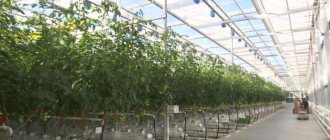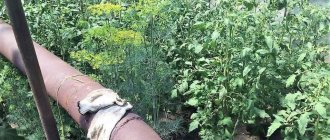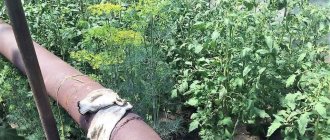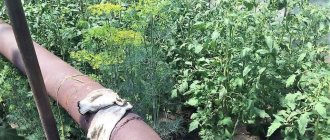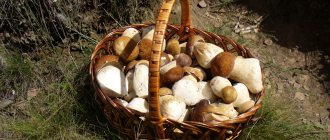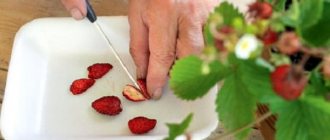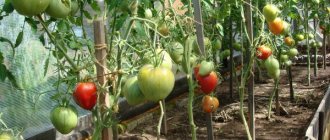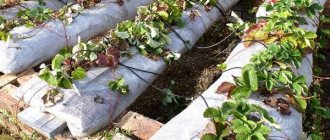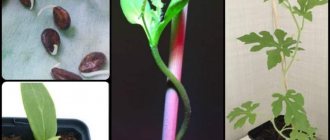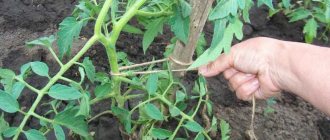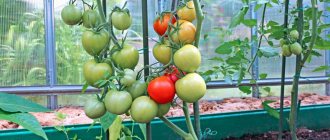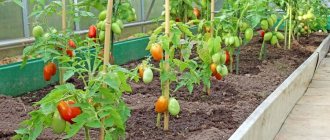Holland has become one of the world leaders in growing vegetables: modern agricultural technologies make it possible to obtain large yields with high quality fruits. Many farmers go to Holland to learn from foreign experience and use it in their own practice. Among all the developments, the Dutch technology for growing tomatoes is of greatest interest: it allows you to get up to 65 kg of ripe, high-quality fruits per square meter of land, so it certainly deserves attention.
Advantages and disadvantages of Dutch technology
When growing tomatoes according to the method used by Dutch vegetable growers, the yield per bush increases several times. A lot of fruits are set, they ripen of the same size, do not crack, and are not deformed during transportation. A method that came from Holland allows you to harvest tomatoes all year round. Plants do not get sick or suffer from pest attacks. The fruits delight with excellent taste and pleasant aroma, regardless of the season in which they ripen.
Preparing a climbing plant for winter
If the vertical beds of strawberries are not high, you can make a special protective structure for the winter from wooden slats, burlap, roofing felt, lutrasil or agril. To prevent climbing strawberries from dying in the harsh conditions of the Russian winter, before the first frost, you must perform the following steps:
- If possible, the best way to overwinter such plants is to move them to a cool room;
- When growing strawberries in hanging pots, they are removed, dug into the ground and covered with burlap, spruce branches, hay or other material;
- If the strawberry was growing on a vertical structure, it will need to be removed and the tendrils laid on the ground. Then it is also covered with any available material.
When tying plant tendrils to a trellis or fence, you need to think about their mobility in advance, because if they remain overwintering in an upright position, they will most likely die.
Which varieties are suitable
Not all vegetables are suitable for planting and cultivation in unusual conditions. To ensure that the fruits in the greenhouse ripen not only in summer, indeterminate tomatoes and medium-sized varieties are selected. To grow using Dutch technology, you should purchase:
- Debut. The hybrid, about 2.5 m high, pleases with a harvest of classic-colored tomatoes weighing from 200 g. From sq. m. meter yields about 10 kg of fruit.
- Honey Moon. Large tomatoes with a pink tint ripen in a little more than 2 months. Harvest in both summer and spring.
- Camry. The indeterminate variety is valued for its productivity; the fruits ripen in winter.
- The tall hybrid Raisa takes root well on mineral substrates. Bright red small tomatoes are protected from damage by their thick skin, can be transported without problems, and do not spoil for a long time.
These varieties of tomatoes produce a harvest when planted normally in a greenhouse. However, when using an effective cultivation method, productivity increases significantly.
Summarizing
The Dutch technology has many fans, but there are also gardeners who want to challenge this technique. They believe that it is impossible to obtain truly aromatic and sweet tomatoes in a greenhouse - for this, in their opinion, only cultivation on the ground, in natural conditions, is suitable.
But it is difficult not to take into account many years of experience in cultivating Dutch tomatoes. When grown in this way, tomato plantings provide the highest yield and productivity, as well as excellent appearance, which is extremely important if the vegetables are sold.
Basic principles of the Dutch method
In order for tomatoes to develop quickly and not be affected by infection, seedlings are rooted not in ordinary soil, but in mineral wool. Only seeds are sown in an earthen substrate. Parasites always live in the soil, and in order to deal with them, it is necessary to treat them with harmful chemicals.
Bugs do not take root in cotton wool; fertilizers are not applied to such a substrate, but shoots and leaves of tomatoes are sprayed with mineral complexes.
Expanded clay is poured onto the bottom of the container for sowing tomatoes, and a substrate is added on top. 5-6 seeds are planted in each box, the grains are covered with vermiculite or wet sand, wrapped in film and taken to a dark place. After 2 weeks, the seedlings are transferred to a plastic container filled with mineral wool.
Arrangement of greenhouses
Dutch technology does not provide for planting vegetable crops in an open garden bed, but only in protected ground. The productivity of the method is influenced by the conditions created in the room in which the tomatoes are grown.
See also
What varieties of tomatoes are best to choose for open ground?
Read
Necessary parameters and requirements
A few days before planting tomatoes, the air temperature in the greenhouse is brought to at least 16 °C, and the substrate is warmed. Be sure to wash windows or plexiglass, which helps improve lighting. In order for the plants to feel comfortable, the temperature must be automatically controlled and be within the range of 16–20 ° C; at night, a decrease of 2 degrees is allowed. Tomatoes do not tolerate cold and do not tolerate changes.
Temperature and ventilation system in the greenhouse
Before planting tomatoes, you need to think about how the soil and bushes will be heated, ventilated, watered, and fertilized. A heating and irrigation system is installed in the greenhouse, the room is provided with ventilation, which maintains humidity at 65%.
Heating must be designed so that:
- The tops of the plants were heated.
- Pollen fell as in natural conditions.
- The tomatoes ripened smoothly and evenly.
Hoses with tubes are laid throughout the greenhouse, which are connected to the sediment. It does not matter whether the water is supplied automatically or manually, but it should not be colder than 16 °C. It is necessary to ensure that drops do not fall on the leaves.
Let's put it into practice
After the bushes have been planted, they need to be watered regularly immediately. Proper watering is the right approach when growing tomatoes. The best watering option is to drip-irrigate the plant from below. To water plants along furrows, it is more effective to use plastic pipes with special perforations, to which you need to connect a hose for watering.
This tactic favorably promotes uniform watering of the plant. The frequency with which tomatoes need to be watered depends on the action and activity of solar radiation, the rate of moisture evaporation, soil moisture, the ventilation system and the maintained temperature inside the greenhouse. For watering plants, the most useful water is after rains or purified water no colder than sixteen degrees. At each stage of plant development, it is imperative to remove dried old leaves.
Be sure to trim flowers for proper development and balance. In the first two tassels you need to leave five flowers each, and in the rest you can have six. Pollination with the help of bees and bumblebees must be carried out up to three times a week. It is this method that affects a larger number of fruits. When the time comes to harvest, the best time for this is early morning; carry out this procedure about four times a week.
And in winter, calmly pick tomatoes, even if they are not yet brightly colored. In the spring and autumn, pick only the most ripened tomato fruits. In order not to damage the collected fruits, it will be effective to put them in boxes or baskets. We put this technology into practice and get excellent yields.
Growing process: step-by-step technology
Tomatoes in a greenhouse bear fruit almost all year round. In the hot period, it will take no more than 40 days to obtain seedlings, in the spring - about 50, in the winter season - up to 60 days. The video helps you understand the growing process.
Preparing the seeds for planting
The seed must first be sorted. To do this, pour one or one and a half tablespoons of salt into a liter jar of water and lower the tomato seeds.
The seeds that have sunk to the bottom are washed and disinfected in potassium permanganate.
Shortly before planting, the seed is hardened, for this purpose it is kept at a temperature of 50–60 ° C, then placed in a cold place, after which it is treated with a growth stimulator. Before being sent into the ground, the seeds are germinated by folding them in a gauze or cloth napkin.
Sowing into the substrate
The place for the prepared planting material must be selected in the most illuminated area of the greenhouse. The soil is prepared by combining peat and river sand. Sowing tomatoes includes several stages:
- Expanded clay is poured onto the bottom of the pot and filled with soil.
- A groove 20 mm deep is made in the container.
- Plant 5 or 6 grains.
- The seeds are covered with a 2-centimeter layer of sand.
- The container is insulated with polyethylene.
Shoots appear earlier than after 2 weeks. Young bushes without soil are moved into containers.
Required starting capital
Growing tomatoes on an industrial scale is not a very expensive business. At the very beginning, huge capital investments will not be required. The main costs will be land rent and greenhouse equipment. Building a greenhouse yourself will greatly reduce costs.
When calculating future income, it is necessary to take into account all costs, both one-time and monthly. Costs include:
- Rent of land;
- Registration of a legal entity;
- Construction and arrangement of a greenhouse;
- Purchase of planting material and fertilizers;
- Electricity and water supply costs;
- Paying taxes;
- Wages of hired workers;
- Packaging and labeling;
- Costs of transport that delivers vegetables.
Some costs can be eliminated:
- Land owners do not have to pay rent;
- Small greenhouses can do without maintenance personnel;
- Branded packaging is required only for large farms with a registered trademark.
Approximate costs for one polycarbonate greenhouse of 100,000 sq. m start from 100,000 rubles. Of this, 10,000 rubles are needed for seeding material, and at least 15,000 rubles for heating.
Land lease
To grow tomato crops, land must be owned or leased. First you need to choose the appropriate location. The ideal choice is a rural or suburban area, close to nature and clean air.
ATTENTION: Similar farms are not recommended nearby to avoid competition
Materials and equipment for greenhouse construction
To build a strong greenhouse that will work all year round and produce a rich harvest, you need to proceed in stages:
- Preparing the site for the greenhouse.
- Construction of the frame and securing the foundation.
- Soil preparation.
- Creation of a heating, ventilation and irrigation system.
- Providing additional lighting.
Timing of seedling formation
When using Dutch technology, certain requirements are imposed on tomatoes. Leave no more than 10 leaves on the first brush. To get strong seedlings, it will take a few weeks:
- in summer - 5;
- in winter - up to 9;
- in spring - about 6.
The stem of the plant should have medium thickness, a short peduncle, and hanging tassels. Tomatoes respond to the creation of favorable conditions with an excellent harvest. Per sq. 2 or 3 tomatoes are placed per meter, leaving at least 60 cm between the rows.
Agricultural technology for growing tomatoes in open ground: planting dates
Correctly chosen planting dates also contribute to the optimal phytosanitary condition of vegetable crops.
Depending on the place of cultivation (protected or open ground), the characteristics of the variety or hybrid, from mid-February to the end of March, cauliflower, broccoli, peppers, eggplants, tomatoes, cucumbers, pumpkin, zucchini and zucchini are sown as seedlings.
The sowing time is determined based on the fact that 60-day-old seedlings of tomatoes are used for planting in closed ground, cabbage - 40-45 days, peppers and eggplants - 55-60 days, zucchini and pumpkin - 20 days, cucumbers - 30 days.
In accordance with correct agricultural technology, tomatoes are planted in open ground after stable warm weather has established, when the threat of return frosts has passed, at the age of 45-60 days, cabbage - in the phase of 4-6 true leaves.
Seedlings must be planted after the return frosts have passed, which happens quite often before the second decade of May.
At the time of planting, the seedlings should be fresh and not wilted. Remember that wilting causes the first flowers to fall off and the early harvest to be lost.
Let us remind you that the best age for seedlings is:
• low-growing varieties - 45-60 days;
• tall - more than 60 days, and it should already have the first flower cluster.
The grown tomato varieties are divided according to their growth strength into low-growing, low-growing and tall-growing, and the planting scheme, or simply put, the nutritional area will be different for each group:
• for low-growing standard varieties - 30 x 50 cm;
• medium height - 40 x 50-60 cm;
• tall (like De Barao and others) - 50 x 60-70 cm.
Plant unovergrown, strong, stocky seedlings into the hole vertically at the same depth as they were in the box or greenhouse; water, mulch.
We recommend planting overgrown seedlings obliquely, covering only the lightly laid stem with soil. Only after a week, when the seedlings have taken root, can the groove be finally filled in, where additional roots will form on the stem. If you immediately deeply bury the stem into the soil, the lower, well-developed roots may die off, and new ones will form on the stem within two weeks. Thus, we delay the entry of tomatoes into the fruiting phase.
According to the technology for growing tomatoes in open ground, immediately after planting, at a distance of no more than 10 cm from the plant, you need to place pegs of appropriate sizes to tie the stems of each group of varieties. And for tall tomatoes, a trellis is pulled at a height of 1.5 m from wire, and then a twine 30% longer is lowered to each plant, i.e. about 2 m, and the plant is tied up using the twisting method for 1.5 months, which results in a total difficulty 4-6 garters.
When there is a threat of frost, seedlings are covered with films such as Lutrasil or Spandbond, Agrospan, Grintex.
Watch the video “Growing tomatoes in open ground”, which shows how to plant seedlings in the garden:
Caring for tomato bushes
When growing vegetables using Dutch technology, you need to properly care for them. Every day you need to go into the greenhouse and monitor the condition of the stems, leaves, and brushes.
Watering and replenishment
Drip irrigation is excellent for moisturizing the roots of tomatoes, in which water flows evenly into the grooves. How often you have to start watering depends on various factors. In hot weather and bright sunshine, moisture quickly evaporates and the soil dries out.
See also
How to properly sow tomato seeds for seedlings, step-by-step guide and steps
Read
With the Dutch growing technology, fertilizers are not applied at the root. Once every 10–14 days, a nutrient composition containing microelements in the form of boron and magnesium is sprayed onto the bushes. With this method of feeding, the composition is better absorbed.
If the acidity of the substrate increases, the tomatoes begin to ripen unevenly and rot. Adding ash helps solve the problem.
Shaping and garter
To extend the period of fruiting, which is facilitated by good lighting, indeterminate tomatoes that grow up to 2.5 m in height are formed into 1 or 2 stems, the stepsons are removed and tied to a support.
A wire is stretched along the greenhouse, one end of the twine is attached to it, the other is secured with a loop between the first and second leaves.
In the brushes that form at the bottom of the bush, the flowers are cut off, leaving only 5; in the upper part of the plant there may be more.
Graft
To create a powerful root system, increase productivity, protect tomatoes from diseases, copulation will be performed. A month before moving the seedlings into the mineral substrate, weak bushes are grafted onto stronger tomatoes. Using a disinfected blade, a 15 mm long cut is made on the stem of both plants above the cotyledon leaves. On the rootstock it should be located from top to bottom, going in the opposite direction from the scion. On each bush, the tongues are split, inserted into each other and wrapped with electrical tape.
After copulation, the seedling forms 2 roots, the tomato develops faster and produces more fruits.
Typical greenhouse design in the Netherlands
Throughout the world, greenhouses of this type are called “Dutch”. I would like to dwell on some of its features. The bodies of all greenhouses are made of aluminum. They are very convenient and easy to assemble. Glazing uses a durable transparent coating called float glass. It has high light transmittance and is practically invulnerable to extreme precipitation, such as large ice and hail.
All Dutch greenhouses are equipped with special gutters that do not allow rainwater to seep through the glazing inside, but collect it in special tanks. Thanks to this innovative design, all farms in the country have double benefits. They receive tons of free rainwater for watering greenhouse plants and thereby save significant money on paying for water from the water supply.
A typical Dutch greenhouse has a frame like this
Another interesting development by engineers from the Netherlands are anti-hurricane terminals, which reliably fix all prefabricated housing structures.
The height of typical industrial-scale greenhouses is usually 5 m or more. It all depends on the wishes of the owner and the characteristics of the crops grown.
Harvesting nuances
The tomatoes ripen uniformly and evenly. They need to be picked carefully and preferably in the morning. In the summer, tomatoes are harvested when the color turns brown; at other times of the year, ripe fruits are harvested. Vegetables are collected 3 or 4 times a week, otherwise the bushes will begin to break under the weight of the tomatoes.
The harvest is placed in boxes or baskets, the bottom of the container is covered with rubber or sprinkled with foam crumbs. To ensure that the last fruits ripen faster, the stems on the bushes are wrapped in polyethylene.
Greenhouse models were tested by nature itself
The first half of the seventies of the last century is considered the starting point in the creation of powerful industrial-scale greenhouse structures that were able to withstand strong storms and hurricanes. It was in 1972-73. The territory of Holland shook under the weight of hail showers and frequent stormy winds.
The structures, which were tested by nature itself, were gradually improved. It was in those years that the NEN 3859 standard was developed, which manufacturers of modern greenhouses still follow today.
Engineers and agronomists are involved in the creation of greenhouses
Greenhouse construction was gradually modernized, new technologies were introduced. Today in Holland the most famous greenhouse manufacturer is the Venlo concern. He is engaged in the construction and installation of internal heating, irrigation, and ventilation systems for greenhouses that extend over thousands of hectares. The company has representative offices in many countries around the world.
